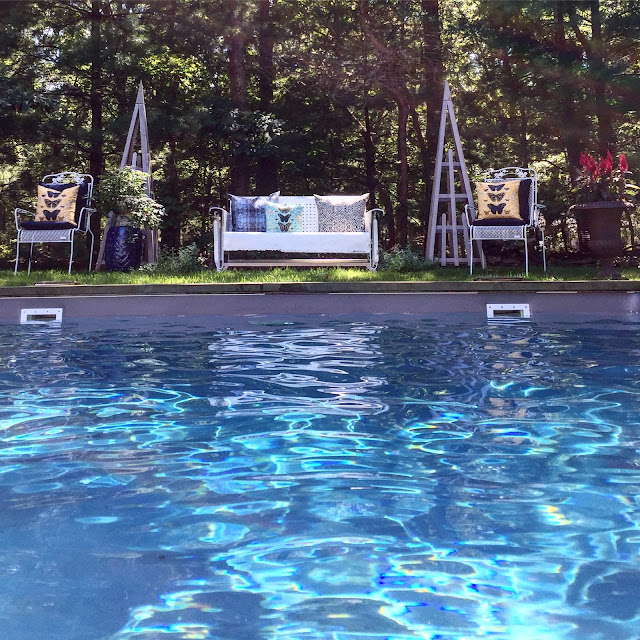Nest by Tamara's Why In Design column today profiles the sturdy, beautiful and historic designs of cabinetmaker, Duncan Phyfe
Why In Design:
America's 19th Century Sweetheart Cabinetmaker--
Duncan Phyfe
Met Museum; circa 1810-1820
Met Museum; circa 1815-1820
How to spot his pieces?
these are quintessentially Duncan Phyfe...
1. tapered, reeded legs on pretty brass casters.
2. symmetrical proportions, curved lines. motifs-- acanthus leaf & Grecian scroll carved legs and columns; harps and lyre carved chair backs (and others harkening Greek and Roman antiques); arrows, circles, drapery swags & plume designs.
3. drop leaf tables with extensions made in rich, dark mahogany, sometimes with exotic veneers.
3. drop leaf tables with extensions made in rich, dark mahogany, sometimes with exotic veneers.
When visiting the MET Museum in New York City, the name Duncan Phyfe comes up often, especially in the decorative art wing where all the beautiful, historic furniture resides. In 1922, The Met was the first museum to dedicate an exhibit to a furniture maker, and Duncan Phyfe was their muse. In design schools around the country, Phyfe is often looked to as the premiere American cabinetmaker. Phyfe did not create his own style, however, he re-interpreted British styles of Neo-Classicism (aesthetics refurbished from classic Greek and Roman styles) in a way that was nuanced and stylized, and this garnered him quick notoriety and popularity in important social circles in America. For two decades he reigned as the leader cabinetmaker with many fans. Let's take a look at what makes him so special...

Met Museum; circa 1835
Duncan Phyfe was a Scottish born immigrant who came to America in the 1700s. After relocating to New York City from Albany, he apprenticed as a cabinet maker and learned the trade. He made a quick name for himself and soon had loyal customers from the wealthiest families in New York, Philadelphia and the South. Phyfe rose to become the most famous and distinctive cabinetmaker in America and soon he had many artisans working for him, hence the name Duncan Phyfe Workshop evolved. He took the best qualities from famous Brits like Thomas Sheraton pulling Regency and Federal, Empire and French Directoire shapes and designs together in a nuanced and quality way.
He set up shops in the fashionable neighborhoods of Fulton Street where the wealthy class visited regularly to shop his furniture. In the mid 1800s he took both of his sons into his business and changed the name to D. Phyfe & sons. The sudden death of one son, brought a few rough years for the firm. However, during the "Roaring Twenties" with a strong revival in furniture making, the loyal patrons were investing strongly again in Phyfe Workshop furniture. Because his pieces were rarely signed, and also due in part to the many "knock offs" in the market, it can be difficult to authenticate. Today, one can find Duncan Phyfe specimens in museums around the country, as well as pieces in the White House's Green Room and other historic homes around the country.
Transformation of the White House's
Green Room Over Time...
Green Room Over Time...
The Green Room, 1963
Kennedy administration via whitehouse.org
with interior decorator, Sister Parish, Jackie Kennedy transformed the White House
The Green Room, 1961
Jackie Kennedy speaking with wife of astronaut,
Alan Shepard
Kennedy administration via whitehouse.org
with interior decorator, Sister Parish, Jackie Kennedy transformed the White House
The Green Room, 1961
Jackie Kennedy speaking with wife of astronaut,
Alan Shepard
The Green Room, 1971
the Nixon refurbishing
"Mrs Nixon's preservation efforts on behalf of the White House included substantial historic furniture acquisition between 1969 and 1974. Fine sophisticated furniture attributed to master New York cabinetmaker Duncan Phyfe, including a Sheraton secretary desk and two pedestal pier tables, were acquired at this time." -Whitehousehistory.org
"Mrs Nixon's preservation efforts on behalf of the White House included substantial historic furniture acquisition between 1969 and 1974. Fine sophisticated furniture attributed to master New York cabinetmaker Duncan Phyfe, including a Sheraton secretary desk and two pedestal pier tables, were acquired at this time." -Whitehousehistory.org
Obama administration the Green Room
Happy Nesting
XO Tamara
storie sources:
Architectural Digest magazine,
Metropolitan Museum of Art, Wikipedia and Whitehousehistory.org













